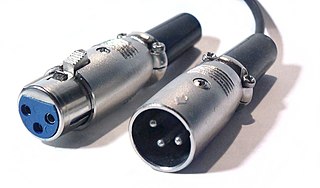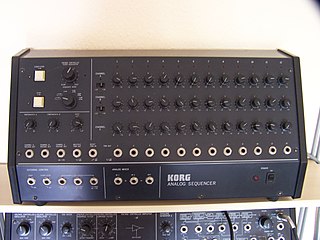The RS Integrator is a series of analog modular synthesizer systems made by British company Analogue Systems, which had previously manufactured the TH48 step sequencer and FB3 Filterbank.

An analogsynthesizer is a synthesizer that uses analog circuits and analog signals to generate sound electronically.

The modular synthesizer is a type of synthesizer, which exists in both physical and virtual forms, consisting of separate specialized modules. The modules are not hardwired together by the manufacturer but are connected together with patch cords, a matrix patching system, or switches by the user to create a patch. The output (voltages) from the modules may function as (audio) signals, control voltages, or logic/timing conditions. Typical modules are oscillators, filters (spectrum), amplifiers/gates (amplitude) and Envelope generators.

The United Kingdom (UK), officially the United Kingdom of Great Britain and Northern Ireland, and sometimes referred to as Britain, is a sovereign country located off the north-western coast of the European mainland. The United Kingdom includes the island of Great Britain, the north-eastern part of the island of Ireland, and many smaller islands. Northern Ireland is the only part of the United Kingdom that shares a land border with another sovereign state, the Republic of Ireland. Apart from this land border, the United Kingdom is surrounded by the Atlantic Ocean, with the North Sea to the east, the English Channel to the south and the Celtic Sea to the south-west, giving it the 12th-longest coastline in the world. The Irish Sea lies between Great Britain and Ireland. With an area of 242,500 square kilometres (93,600 sq mi), the United Kingdom is the 78th-largest sovereign state in the world. It is also the 22nd-most populous country, with an estimated 66.0 million inhabitants in 2017.
As with Doepfer's similar A-100 system, modules are designed to be mounted in a standard 19-inch rack enclosure, each module measuring 3U in height. Modules are patched using standard mono miniature (3.5 mm) leads.
Doepfer Musikelektronik GmbH is a manufacturer of audio hardware, mostly synthesizer modules, based in Gräfelfing, Germany and founded by Dieter Döpfer. The product range covers analog modular systems, MIDI controllers, MIDI hardware sequencers, MIDI-to-CV/Gate/Sync Interfaces, MIDI master keyboards and special MIDI equipment.

The Doepfer A-100 is an analog modular synthesizer system introduced by German audio manufacturer Doepfer in 1995. Although it only had 10 modules at time of release, it currently has more than 120 modules plus several different enclosures and accessories.

A 19-inch rack is a standardized frame or enclosure for mounting multiple electronic equipment modules. Each module has a front panel that is 19 inches (48.3 cm) wide. The 19-inch dimension includes the edges, or "ears", that protrude on each side which allow the module to be fastened to the rack frame with screws. Common uses include computer server, telecom, broadcast video, lighting, audio, and scientific lab equipment.
Various controller keyboards are available within the RS Integrator series, including the Sorceror (sic), which can house modules inside its wooden enclosure.
Dolby Digital is the name for audio compression technologies developed by Dolby Laboratories. Originally named Dolby Stereo Digital until 1994, except for Dolby TrueHD, the audio compression is lossy. The first use of Dolby Digital was to provide digital sound in cinemas from 35mm film prints; today, it is now also used for other applications such as TV broadcast, radio broadcast via satellite, digital video streaming, DVDs, Blu-ray discs and game consoles.
A music sequencer is a device or application software that can record, edit, or play back music, by handling note and performance information in several forms, typically CV/Gate, MIDI, or Open Sound Control (OSC), and possibly audio and automation data for DAWs and plug-ins.

The Freescale 683xx is a family of compatible microcontrollers that use a Motorola 68000-based CPU core. The family was designed using a hardware description language, making the parts synthesizable, and amenable to improved fabrication processes, such as die shrinks.

A groovebox is a self-contained instrument for the production of live, loop-based electronic music with a high degree of user control facilitating improvisation. The term "Groovebox" was originally used by Roland Corporation to refer to its MC-303, released in 1996. The term has since entered general use, and dates back to the Movement Computer Systems Drum Computer in 1981.
A music workstation is an electronic musical instrument providing the facilities of:

The XLR connector is a style of electrical connector, primarily found on professional audio, video, and stage lighting equipment. The connectors are circular in design and have between three and seven pins. They are most commonly associated with balanced audio interconnection, including AES3 digital audio, but are also used for lighting control, low-voltage power supplies, and other applications. XLR connectors are available from a number of manufacturers and are covered by an international standard for dimensions, IEC 61076-2-103. They are superficially similar to the smaller DIN connector range, but are not physically compatible with them.
Integration testing is the phase in software testing in which individual software modules are combined and tested as a group. Integration testing is conducted to evaluate the compliance of a system or component with specified functional requirements. It occurs after unit testing and before validation testing. Integration testing takes as its input modules that have been unit tested, groups them in larger aggregates, applies tests defined in an integration test plan to those aggregates, and delivers as its output the integrated system ready for system testing.

A sound module is an electronic musical instrument without a human-playable interface such as a piano-style musical keyboard. Sound modules have to be operated using an externally connected device, which is often a MIDI controller, of which the most common type is the musical keyboard. Controllers are devices that provide the human-playable interface and which may or may not produce sounds of its own. Another common way of controlling a sound module is through a sequencer, which is computer hardware or software designed to record and play back control information for sound-generating hardware. Connections between sound modules, controllers, and sequencers are generally made with MIDI, which is a standardized protocol designed for this purpose, which includes special ports (jacks) and cables.

The Korg MS-20 is a patchable semi-modular monophonic analog synthesizer which Korg released in 1978 and which was in production until 1983. It was part of Korg's MS series of instruments, which also included the single oscillator MS-10, the keyboardless MS-50 module, the SQ-10 sequencer, and the VC-10 Vocoder. Additional devices included the MS-01 Foot Controller, MS-02 Interface, MS-03 Signal Processor, and MS-04 Modulation Pedal.

The Yamaha Motif is a series of music workstation synthesizers, first released by Yamaha Corporation in August 2001. The Motif replaced the EX series in Yamaha's line-up. Other workstations in the same class are the Korg Kronos and the Roland Fantom G.

The Clavia Nord Modular series is a line of synthesizers produced by Clavia, a Swedish digital synthesizer manufacturer. The Nord Modular series, in common with their sister range the Nord Lead series, are analogue modelling synthesizers, producing sounds which approximate those produced by conventional analogue synths by using DSP chips to digitally model analogue circuitry.

The Access Virus is a virtual analog synthesizer made by the German company Access Music GmbH. It was first produced in 1997 and has since been upgraded frequently, with the company releasing new models about every two years. Early models include the Virus A, Virus B, and Virus C series, each available in various hardware configurations. In November 2005, the Virus TI series was released, including the 61-key Virus TI Keyboard and the 37-key Virus TI Polar. A small desktop model was released in February 2008 called the Virus TI Snow. A revision of the TI series called TI2 came out in March 2009, featuring faster digital signal processing (DSP), greater polyphony, more effects in the effect section and a slightly changed design. The Virus series also has come out with two software plugin versions: TDM for Pro Tools and VST for TC Electronic Powercore series. The term Access Virus can be used to refer to any one of these synthesizers.

The Roland MC-909 Sampling Groovebox combines the features of a synthesizer, sequencer, and sampler, with extensive hands-on control of both the sound engine and the sequencing flow. It was intended primarily for live performance of pre-programmed patterns consisting of up to 16 tracks of MIDI data. It was released by Roland Corporation on October 8, 2002. This product was announced at the AES Fall Convention in 2002. It is the direct successor to the Roland MC-505, and is the predecessor to the Roland MC-808 which eventually ended the "Groovebox" line of products by Roland which began in the mid 1990s with the original MC-303.
It was developed from the blueprint of Roland's own "Fantom" workstation and uses the same structure and operating system, with some differences regarding the Patterns section, not implemented in the Fantom.

The Serge synthesizer is an analogue modular synthesizer system originally developed by Serge Tcherepnin, Rich Gold and Randy Cohen at CalArts in late 1972. The first 20 Serge systems were built in 1973 in Tcherepnin's home. Tcherepnin was a professor at CalArts at the time, and desired to create something like the exclusively expensive Buchla modular synthesizers "for the people that would be both inexpensive and powerful." After building prototypes, Tcherepnin went on to develop kits for students to affordably build their own modular synthesizer, production taking place unofficially on a second floor Calarts balcony. This led to Tcherepnin leaving CalArts in order to produce kits commercially, starting in 1974.

An analog sequencer is a music sequencer constructed from analog (analogue) electronics, invented in the first half of the 20th century.

Yamaha CX5M is an MSX-system compatible computer that expands upon the normal features expected from these systems with a built-in eight-voice FM synthesizer module, introduced in 1984 by Yamaha Corporation.
















